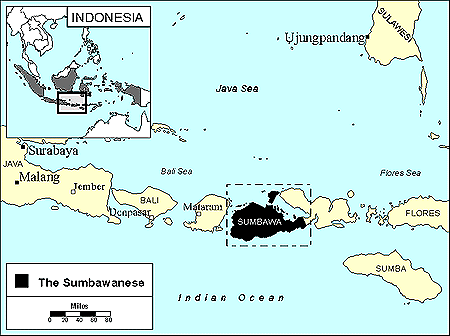|
|
Prayer Profile
The Sumbawanese of Indonesia
![[IMAGE]](../images5/0810.jpg) Indonesia is the fourth most populous nation in the world and has one of the most ethnically diverse populations. There are more than 300 distinct people groups, many of whom are Muslim. One of these groups is the 327,800 Sumbawanese.
Indonesia is the fourth most populous nation in the world and has one of the most ethnically diverse populations. There are more than 300 distinct people groups, many of whom are Muslim. One of these groups is the 327,800 Sumbawanese.
The name "Sumbawa" originally referred to the western part of Sumbawa Island, whereas the eastern part was called "Bima." Today, however, the entire island is known as Sumbawa. The two groups inhabiting the island, the Sumbawanese and the Bimanese, are culturally quite similar, although there are some differences in dialects.
Despite Sumbawa's long coastline, most villages lie about five kilometers or more inland. Much of the land consists of open country dotted with small clusters of trees and shrubs. Rice is farmed year round along the northern river coasts and the central river valleys. The climate is tropical, with little daily variation in temperature. There are, however, distinct wet and dry seasons.
What Are Their Lives Like
The Sumbawanese lifestyle revolves around farming. Agriculture is of three main types: wet rice fields, dry rice fields, and garden plots with seasonal crops. Rice remains the major crop, but secondary crops (mainly for export) include onions, beans, and some tobacco and coffee. Fruits and vegetables are grown in the gardens around the villages. Fishing is relatively unimportant, although the people do have fish ponds from which they extract salt during the dry season. Because Sumbawa is rich in forest products, the people also gather a large amount of nuts, as well as rattan (a type of palm) and beeswax. Water buffaloes are also very important to the Sumbawanese, and many of them are used in the area.
A Sumbawanese village is often composed of individual settlements. In the mountains, the people live on swiddens (land that has been cleared by "slash and burn" agriculture) for part of the year. After harvesting the crops, however, they return to their home villages. Each village usually has its own mosque. The head of the mosque is responsible for all ceremonies, religious anniversaries, and the rites of the agricultural cycle.
The Sumbawanese houses are very nice and closely resemble those of the Makassarese and Buginese. The houses consist of four to six rooms, with partitions that are easily moved so that an extra room may be added when a married daughter comes to live with her parents.
Sumbawanese descent is traced through both the males and females, and the circle of kinship is divided into various sub-groups. The center, however, is the nuclear family, composed of a man, woman, and their children. If a Sumbawanese man wishes to marry, he sends an eloquent woman to the house of the prospective bride. Acting as his representative, she makes the marriage proposal for him in very descriptive language. A bride-price is then paid, dependent on the social status of the woman. After marriage, the young couple lives with the bride's parents at first, as the husband must render bride-service (work for the bride's family) for a considerable length of time.
What Are Their Belief?
The Sumbawanese are predominantly Shafi'ite Muslims, but many animistic practices (belief that non-human objects have spirits) are still evident behind the veneer of Islam. There are still many shamans (witch doctors) in Sumbawanese communities, and many of those professing Islam still rely on the shamans' advice and help, especially during times of crisis.
What Are Their Needs?
There are no Christian resources for church growth or evangelism available in the Sumbawa language. As a result, the great majority of the Sumbawanese have never heard a clear presentation of the Gospel. Three missions agencies are currently working among the group, but the number of converts remains small. The Bible and evangelistic tools such as the Jesus film need to be translated into their native language. Above all, continued prayer must be made to see this group effectively penetrated with the Light of the Gospel.
Prayer Points
- Ask the Lord to send missionaries who will invest their lives in the Sumbawanese.
- Ask the Holy Spirit to grant wisdom and favor to the missions agencies that are targeting the Sumbawanese.
- Pray that the Bible and the Jesus film will soon be translated into the Sumbawa language.
- Ask the Lord Jesus to reveal Himself to the Sumbawanese through dreams and visions.
- Pray that signs and wonders will follow the Sumbawanese believers as they share Christ with their own people.
- Take authority over the spiritual principalities and powers that are keeping the Sumbawanese bound.
- Ask God to raise up prayer teams who will daily intercede for the Sumbawanese.
- Ask the Lord to bring forth a triumphant Sumbawanese church for the glory of His name!

Statistics
Latest estimates from the World Evangelization Research Center.
THE PEOPLE
- People name: Sumbawanese
- Country: Indonesia
- Their language: Sumbawa
- Population:
- Largest religion:
- Christian: <1%
- Church members: 33
- Scriptures in their own language: None
- Jesus Film in their own language: None
- Christian broadcasts in their own language: None
- Mission agencies working among this people: 3
- Persons who have heard the Gospel: 55,800 (17%)
- Persons who have never heard the Gospel: 272,000 (83%)
THEIR COUNTRY
- Country: Indonesia
- Population:
- Major peoples in size order:
- Major religions:
- Number of denominations: 113
© Copyright 1997
Bethany World Prayer Center
This profile may be copied and distributed without obtaining permission
as long as it is not altered, bound, published
or used for profit purposes.
![[HOME BUTTON]](../graphics/home.jpg)
![[CALENDAR BUTTON]](../graphics/calico.jpg)
![[LIST BUTTON]](../graphics/listico.jpg)
[Home]
[Calendar]
[Country List]
|